
Have you ever been lost in a big capital city, without batteries in your phone or credit on your SIM card? And when was the last time you’ve bought one of these unfoldable paper maps? Luckily, there’s one thing you can always rely on when you’re completely lost in France: helpful locals!
But it comes at a price. Outside of Paris, it can be difficult to find English-speaking help and you’ll have to be ready to break the language barrier. Asking directions in French is easy. Understanding the answer is a different story (but “left” and “right” in French aren’t hard). Don’t worry, we’ll get you there. =)
First, you’ll need to know the basic vocabulary, such as right, left, North, or South in French. But you’ll also need to know the usual movement verbs and the most common structures. In this guide, we’ll cover everything you need to know to find your way around France, from the landmarks to the transportation, taxi phrases, and polite greetings. Time to hit the road!

Table of Contents
- On the Map: Compass Directions in French
- Simple Directions in French Using Landmarks
- On the Road: Driving Directions in French
- Must-Know Phrases: Asking for Directions
- Must-Know Phrases: Giving Directions in French
- The French vs. Directions
- How FrenchPod101 Can Help You Learn More French
1. On the Map: Compass Directions in French

Whether you prefer the modern conveniences of a GPS or ever-reliable paper maps, and whenever you’re navigating through unknown regions or talking about the French territory with your local friends, you’ll need to know the basic cardinal directions and how to use them in sentences.
So, before we dive into anything more complex, let’s start with that!
| Le nord “North” | Nous irons vers le nord. “We will head north.” |
| Le sud “South” | Elle habite au sud de Paris. “She’s living south of Paris.” |
| L’est “East” | Annecy est à deux heures à l’est de Lyon. “Annecy is two hours east of Lyon.” |
| L’ouest “West” | L’europe de l’ouest “Western Europe” |
| Le nord-est “Northeast” | Ils vivent au nord-est de la Russie. “They are living northeast of Russia.” |
| Le nord-ouest “Northwest” | Le nord-ouest des Alpes est une belle région. “The northwest of the Alps is a beautiful region.” |
| Le sud-est “Southeast” | Il fait toujours beau dans le sud-est. “It’s always sunny in the southeast.” |
| Le sud-ouest “Southwest” | Je ne suis jamais descendu dans le sud-ouest. “I’ve never been down southwest.” |
Now that you know how to navigate map directions in French, here are a few more useful words to talk about the French territory:
| Région “Region” | La région Hauts-de-France “The Hauts-de-France region” |
| France is divided into thirteen regions whose names changed recently, in 2016. | |
| Département “Department” | Le Pas-de-Calais est un département Français. “Pas-de-Calais is a French department.” |
| Each region is subdivided into smaller departments. There are currently 101 departments on the French territory, including overseas departments. | |
| La côte “The coast” | On va sur la côte pour l’été. “We’re heading to the coast for the summer.” |
| La frontière “The border” | Elle habite près de la frontière Belge. “She’s living near the Belgium border.” |
- → Make sure to visit our vocabulary list about Direction Words, with audio recordings to practice your pronunciation. It’s freely available on FrenchPod101.
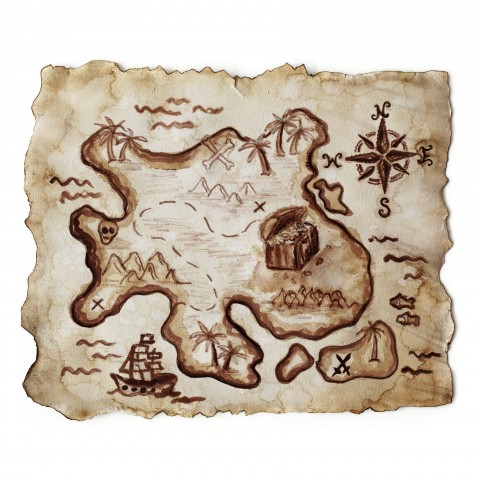
Une carte aux trésors (“A treasure map”)
2. Simple Directions in French Using Landmarks
Time to fold your map and get down to business! You’ve arrived at your destination, but there’s still a lot of unknown ground to cover. You’ll need some serious vocabulary to navigate through this new city and ask locals for directions.
In this chapter, we’ll cover all the essential city landmarks, from transport hubs to city buildings, streets, and key indoor locations.
1- Transports
| Un aéroport “Airport” | Je voudrais aller à l’aéroport d’Orly. “I would like to go to the Orly airport.” |
| Une gare “Train station” | Mon train part de la gare Montparnasse. “My train is leaving from the Montparnasse station.” |
| Une gare routière Une gare de bus “Bus station” | Pouvez-vous m’indiquer la gare routière ? “Could you tell me where the bus station is?” |
| Une station de métro “Metro station” | Je cherche la station de métro la plus proche. “I’m looking for the closest metro station.” |
| Un parking “Parking” | J’ai laissé ma voiture au parking. “I left my car at the parking.” |
2- In the City
| Un hotel “Hotel” | Une nuit d’hotel “A hotel night” |
| Un parc “Park” | Je me promène au parc de Fontainebleau. “I’m strolling at the Fontainebleau park.” |
| Une banque “Bank” | Je dois aller à la banque pour un retrait. “I need to go to the bank for a withdrawal.” |
| Un magasin “Shop” | Un petit magasin d’antiquités “A small antique shop” |
| Une poste “Post office” | Je vais déposer mon colis à la poste. “I will drop my parcel at the post office.” |
| Un marché “Market” | Je fais mes courses au marché le samedi. “I shop at the market on Saturdays.” |
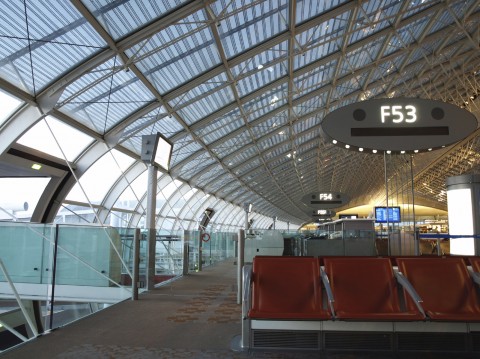
Un aéroport (“Airport”)
3- In the Street
| Un rue “Street” | J’habite rue Saint Martin. “I live on the Saint Martin street.” |
| Une avenue “Avenue” | L’avenue Baltique est près du rond-point Albert II. “The Baltique Avenue is near the Albert II roundabout.” |
| Un croisement; une intersection “Intersection” | On te prendra à cette intersection. “We’ll pick you up at the intersection.” |
| Un feu “Traffic light” | Je m’arrête au feu rouge et j’attends le feu vert. “I stop at the red light and wait for the green light.” |
| The literal meaning of Un feu is “Fire,” but we don’t actually use boric acid to make green fire at our intersections! You should probably not do it at home either. | |
| Une station service “Gas station” | On va faire le plein à la prochaine station service. “We will refuel at the next gas station.” |
| Un passage piéton “Crosswalk” | Il y a un passage piéton sur votre gauche. “There is a crosswalk on your left.” |
4- Key Indoor Locations
| Les toilettes “Toilets” | Excusez-moi, je cherche les toilettes. “Excuse me, I’m looking for the toilets.” |
| Un ascenseur “Elevator” | Prenez l’ascenseur si votre sac est lourd. “Take the elevator if your bag is heavy.” |
| Un escalator “Escalator” | Prenez l’escalator jusqu’au troisième étage. “Take the elevator up to the third floor.” |
| Des escaliers “Stairs” | Descendez les escaliers jusqu’au parking sous-terrain. “Take the stairs down to the underground parking.” |
| L’entrée “Entrance” | L’entrée principale “The main entrance” |
| La sortie “Exit” | La sortie de secours “The emergency exit” |
| Les caisses “Cashier” | Où sont les caisses, s’il vous plait ? “Where is the cashier, please?” |
- → Learn more about city locations with our free vocabulary list on the most useful words to navigate Around Town.
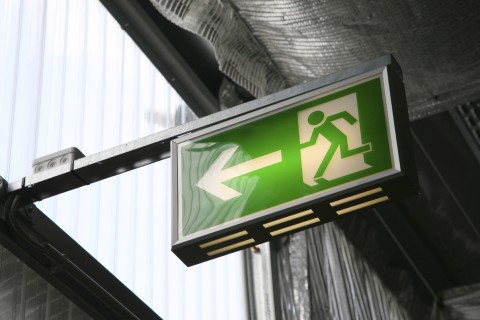
La sortie de secours (“The emergency exit”)
3. On the Road: Driving Directions in French
When you’re asking for directions or explaining to somebody how to reach their destination, you’ll need to know how to say “left” and “right” in French, but that’s not it! There are many direction words you can use to precisely pinpoint a location or accurately describe a route.
Here are the most frequently used words for telling directions in French:
| Devant “In front of” | On se retrouve devant la gare. “Let’s meet in front of the train station.” |
| Derrière “Behind” | Mon taxi attend derrière la gare. “My cab is waiting behind the train station.” |
| La gauche “Left” | La première à gauche “First on the left” |
| La droite “Right” | La troisième à droite “Third on the right” |
| Loin “Far” | Est-ce que c’est loin d’ici ? “Is it far from here?” |
| Près “Near” | Je travaille près de la poste. “I work near the post office.” |
| A côté de “Next to” | A côté de l’arrêt de bus “Next to the bus stop” |
| De l’autre côté de “On the other side of” | De l’autre côté de la rue “On the other side of the street” |
| En face de “In front of” | En face de la cathédrale “In front of the cathedral” |
| A l’opposé de “Opposite” | A l’opposé de “Opposite” |
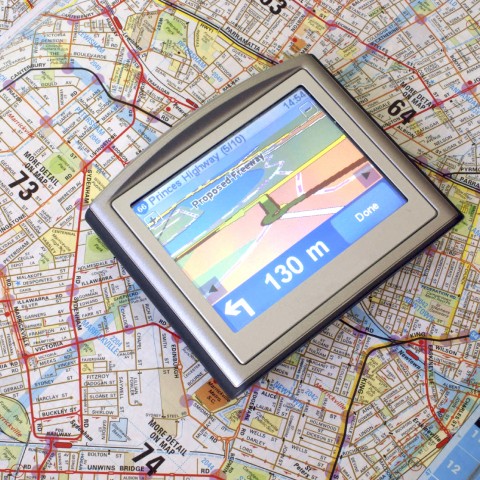
Un GPS de voiture (“Car GPS”)
4. Must-Know Phrases: Asking for Directions
Now that you’re equipped with a solid vocabulary on directions and many example phrases, let’s take a moment to address what I call the “social lubricant”: a bit of gentle grease to polish your interactions with locals and make them pleasantly smooth.
In other words, let’s make your mom proud and learn how to be polite in French!
1- Making First Contact
Here’s your bread-and-butter:
- Bonjour
“Hello” / “Good morning” / “Good day” - Bonsoir
“Good evening” - Excusez-moi
“Excuse me”
From these few words, you can make different combinations, the most polite (that I usually keep for an elderly audience) being:
- Bonjour monsieur, excusez-moi…
“Hello sir, excuse me…” - Bonjour madame, excusez-moi…
“Hello madam, excuse me…”
2- Ask for Help
Here are a few variations on “where is”:
- Est-ce que vous savez où est la Cathédrale Saint-Machin ?
“Do you know where the Saint-Machin Cathedral is?” - Je cherche la place Dauphine.
“I’m looking for the Place Dauphine.” - Pouvez-vous m’indiquer la rue Sainte-Bidule ?
“Can you tell me where the Saint-Bidule street is?”
And a couple questions on distances:
- Est-ce qu’on est loin de la gare Montparnasse ?
“Are we far from the Montparnasse station?” - Est-ce que vous pouvez m’indiquer le métro le plus proche ?
“Can you tell me where the closest metro station is?”
3- Wrap Things Up
- Merci.
“Thank you.” - Merci beaucoup !
“Thank you very much!” - Merci pour votre aide.
“Thank you for your help.”
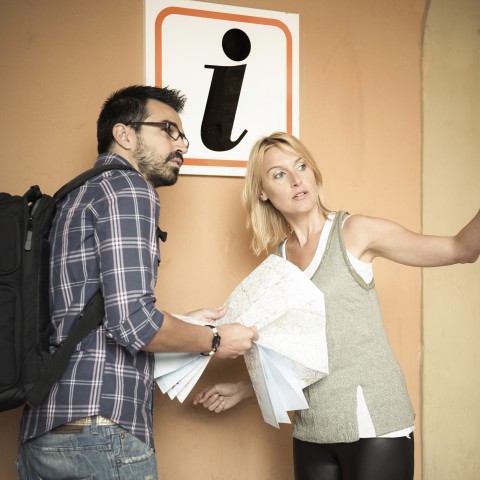
Sometimes, it takes a wrong turn to get to the right place.
5. Must-Know Phrases: Giving Directions in French
There are a few situations where you’ll need to give directions:
- When explaining to friends where you live
- If you blend in so well that locals start asking you for directions (it will happen before you know it!)
- While in a taxi, navigating your driver toward your destination
Here’s one last list of useful words, as well as the most common phrases in everyday situations.
1- Horizontal Directions
| Tout droit “Straight” | Marchez tout droit pendant 100 mètres. “Walk straight for 100 meters.” |
| Faire demi-tour “To double back” | Roulez jusqu’au prochain rond-point et faites demi-tour. “Drive until the next roundabout and double back.” |
| Tourner “To turn” | Après l’église, tournez à gauche. “After the church, turn left.” |
2- Vertical Directions
| Un étage “Floor” | J’habite au 7ème étage, sans ascenseur. “I live on the seventh floor, without a lift.” |
| Un sous-sol “Underground” | Un sous-sol “Underground” |
| En haut “Up” | En haut “Up” |
| En bas “Down”; “Downstairs” | Il y a une épicerie en bas de chez moi. “There is a grocery store downstairs from my place.” |
3- Taxi Directions in French
| Continuer “To continue”; “To keep going” | Continuez un peu, jusqu’au bout de la rue. “Keep going a bit, until the end of the street.” |
| Plus loin “Further” | Non, c’est plus loin sur cette avenue. “No, it is further on this avenue.” |
| S’arrêter “To stop” | Vous pouvez vous arrêter ici. “You can stop here.” |
| Ralentir “To slow down” | Vous pouvez ralentir un peu, s’il vous plaît ? “Could you please slow down a bit?” |
- → To learn more words and their pronunciation, check out our free vocabulary list on Position & Direction.

“Could you start going down? I live a few blocks from here!”
6. The French vs. Directions
Asking a random person for directions is like playing roulette. Sometimes, you’ll bump into another tourist who might very well know the surroundings. Or you’ll face a high-tech teenager, shocked at your inability to rely on a map app, or someone—like myself—who doesn’t know more than two or three street names in the city where they spent ten years.
1- The Lost Art of Knowing Street Names
Best case scenario? You’ll meet one of these old-timers who grew up without modern smartphones and don’t see the point in carrying a GPS outside of their car, if any. They’ve memorized the name of every single street, from center to suburb, and will be only too happy to share their nearly extinct knowledge with you.
Knowing the street names and the most optimized way to get from point A to point B without any GPS-driven help is definitely a matter of generation, and elderly French will be your best friends! Just don’t forget to address them respectfully, using your most humble Bonjour monsieur and Merci beaucoup.
2- I Don’t Know!

What do people do when asked for directions to a place they don’t know? In some countries, they would simply admit they don’t know, but if you’re in one of the South-East Asian countries where saving face matters more than telling the truth, it’s more complicated. I once found myself helplessly wandering through the streets, looking for an embassy because every single local would describe me all kinds of random directions, only not to admit they didn’t have a clue.
In France, when people don’t know what you’re looking for, or aren’t sure how to describe the directions, they’ll simply tell you Je ne sais pas (“I don’t know”) or Aucune idée ! (“No idea!”) and it’s a blessing.
3- French Perception of Distances
Although cars are popular and as overused as in any wealthy country, the French still have the culture of walking, and it shows in their appreciation of distances.
On a trip abroad, I once asked for the nearest bakery and was told “Oh no, it’s way too far to walk there, you should take a taxi!” Having nothing but time, I walked there anyway and found it after five minutes of my long stride. In my personal perception of distances, it was absolutely within walking reach, but locals would take their bikes for shorter errands.
Most French wouldn’t take their cars for less than a kilometer and when they give you walking directions, keep this walking culture in mind. They won’t blink if you tell them you want to walk from the Eiffel Tower to Montmartre. Sure, go ahead, it’s just a one-hour walk!
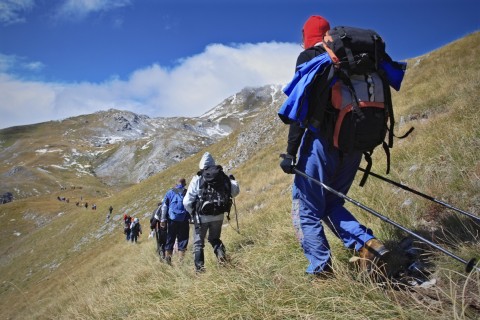
Typical French vacations. Better take your hiking poles!
7. How FrenchPod101 Can Help You Learn More French
In this guide, you’ve learned everything about asking and giving directions in French, from the most common structures to situation-specific vocabulary, polite greetings, and map navigation. Did I forget any important word or phrase that you know? Do you feel ready to get lost in Paris and valiantly ask your way around the capital?
FrenchPod101 also has tons of vocabulary lists with audio recordings and free resources to boost your studies and keep your French learning fresh and entertaining!
Remember that you can also use our premium service, MyTeacher, to get personal one-on-one coaching and have your private teacher help you practice with directions and more. They’ll provide you with assignments and personalized exercises, and will record audio samples for you as well as review yours, to help improve your pronunciation.
Happy learning on FrenchPod101!
About the Author: Born and bred in the rainy north of France, Cyril Danon has been bouncing off various jobs before he left everything behind to wander around the wonders of the World. Now, after quenching his wanderlust for the last few years, he’s eager to share his passion for languages.










